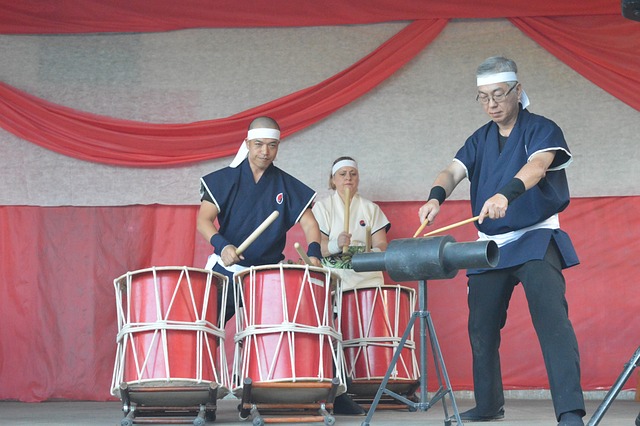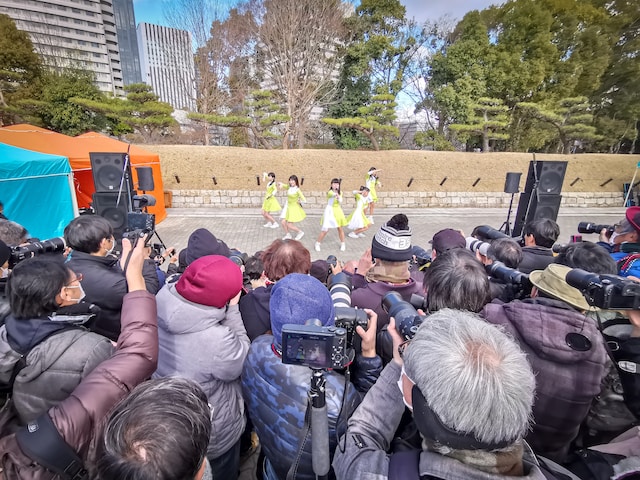
Japanese music, with its distinct tonalities and melodies that resonate deeply within the heart, offers a captivating experience like no other. From the enchanting strains of traditional instruments such as the koto and shakuhachi, to the pulsating beats of contemporary J-pop and J-rock, the diverse world of Japanese music beckons us into a realm where time stands still and the imagination soars.
At first glance, Japanese music may seem like an enigmatic tapestry woven with threads from the past and present. Its roots can be traced back centuries to the sacred chants performed in Shinto rituals and the courtly music of the Heian period. Over time, it has evolved and reinvented itself, absorbing influences from neighboring cultures and global trends, creating a striking fusion of the ancient and the avant-garde.
To explore the multifaceted world of Japanese music is to embark on a journey that traverses through a landscape of artistry and innovation. Traditional genres like Gagaku, Noh theater music, and Kabuki music evoke a sense of timelessness, transporting listeners to a realm imbued with solemnity and grace. Meanwhile, the captivating melodies of folk music, such as minyo and enka, capture the essence of everyday life, narrating stories of love, longing, and the beauty found in the simplicity of existence.
However, it is the realm of contemporary Japanese music that truly astounds and captivates the global audience. A myriad of genres has emerged, each with its own distinct identity and fervent following. J-pop, with its infectious melodies and energetic beats, dominates the charts, while J-rock sets arenas ablaze with its electrifying performances. From the angelic voices of idol groups to the rebellious soundscapes of visual kei bands, the contemporary Japanese music scene brims with creativity, quirkiness, and a fearless exploration of new sounds.
Beyond these well-known genres, there lies a vibrant tapestry of experimental music, underground movements, and genre-bending collaborations, constantly pushing boundaries and challenging conventions. Japanese music embraces the avant-garde, welcoming artists who dare to defy norms and create sonic landscapes that resonate with the depths of human emotion.
Contemporary Japanese Music Genres
As the world continues to be enthralled by the infectious beats and mesmerizing melodies of Japanese music, the contemporary scene unveils a vast array of genres that cater to diverse tastes and preferences. From the catchy tunes of J-pop to the rebellious spirit of J-rock, these genres have garnered immense popularity not only within Japan but also among music enthusiasts worldwide. Let us delve into the captivating world of contemporary Japanese music and explore some of its most prominent genres.
J-pop:
J-pop, short for Japanese pop, has become a cultural phenomenon that dominates the music charts in Japan. Known for its infectious melodies, catchy hooks, and high-energy performances, J-pop encapsulates the essence of modern Japanese popular culture. With its wide appeal and diverse subgenres, J-pop artists command immense fan bases, both domestically and internationally.

Subgenres of J-pop include:
Idol pop: Fueled by charismatic performers and choreographed dance routines, idol pop focuses on creating personalities around groups of young, talented individuals.
Shibuya-kei: Originating from Tokyo’s vibrant Shibuya district, Shibuya-kei combines elements of pop, jazz, and electronica, resulting in a unique and retro-infused sound.
J-rock:
J-rock, or Japanese rock, is a genre known for its energetic performances, powerful guitar riffs, and expressive lyrics. From the iconic bands of the 80s and 90s to the contemporary rock acts, J-rock has a dedicated following, both in Japan and across the globe. It encompasses a wide range of styles, from alternative rock and punk to heavy metal and visual kei.
Subgenres of J-rock include:
Visual kei: Characterized by flamboyant and theatrical aesthetics, visual kei pushes the boundaries of self-expression through elaborate costumes, makeup, and extravagant stage performances.
Alternative rock: Influenced by Western rock music, Japanese alternative rock often incorporates elements of punk, grunge, and indie rock, delivering a unique twist to the genre.
Electronic Music:
Japanese electronic music has gained prominence in recent years, showcasing innovative approaches to sound production and composition. This genre encompasses a broad spectrum, ranging from ambient and experimental sounds to upbeat dance tracks. With a growing number of electronic music festivals and events, Japan has cultivated a thriving electronic music scene.
Subgenres of electronic music in Japan include:
Techno: Characterized by its driving beats and repetitive patterns, techno finds a devoted following in Japan’s nightclubs and underground music scenes.
Chiptune: Embracing the nostalgic sounds of vintage video game consoles, chiptune artists craft music using old-school synthesizers, creating a unique blend of electronic and retro gaming culture.
Influential Japanese Musicians and Bands

Within the rich tapestry of Japanese music, there are numerous influential musicians and bands who have left an indelible mark on the industry. From visionary singer-songwriters who have inspired generations with their introspective lyrics, to innovative bands that have reshaped the sonic landscape, these artists have not only captivated audiences within Japan but have also gained a dedicated following worldwide.
Hikaru Utada – The Voice of a Generation
Hikaru Utada, often referred to as the “Japanese Madonna,” rose to prominence in the late 1990s with her debut album “First Love.” With her soulful vocals and introspective songwriting, Utada’s music struck a chord with a generation struggling to find their identity in a rapidly changing world. Her poignant lyrics, accompanied by hypnotic melodies, touched on themes of love, loss, and self-discovery. Utada’s influence extends far beyond the borders of Japan, as her music became a soundtrack to the lives of many around the globe.
X Japan – The Pioneers of Visual Kei
X Japan, formed in the 1980s, is often credited as the pioneers of the visual kei movement. Led by the enigmatic Yoshiki, the band blended elements of rock, metal, and symphonic music, creating a sound that defied conventional genres. Their theatrical performances, incorporating elaborate costumes and dramatic stage presence, allowed them to transcend musical boundaries and connect with a passionate global fan base. X Japan’s music not only left an indelible mark on the visual kei scene but also inspired subsequent generations of musicians to push creative boundaries.
Shiina Ringo – The Avant-Garde Songstress
Shiina Ringo, known for her powerful vocals and eclectic musical style, is often hailed as one of Japan’s most innovative musicians. With her genre-bending approach to music, Ringo seamlessly incorporates elements of jazz, rock, and pop into her songs, resulting in a truly unique sonic experience. Her lyrics, infused with wit and social commentary, resonate with audiences on a deep level. Ringo’s fearless exploration of musical boundaries and unparalleled artistry have solidified her status as a trailblazer in the Japanese music industry.
Radwimps – The Voice of Modern Japan
Radwimps, formed in 2001, has emerged as a leading force in the contemporary Japanese music scene. Known for their evocative lyrics and intricate instrumentations, the band captures the essence of modern Japanese society and the emotional journeys of its youth. Radwimps gained international recognition for their soundtrack to the critically acclaimed anime film “Your Name,” further solidifying their influence within and beyond Japan. With their dynamic sound and resonant lyrics, Radwimps continues to shape the soundscape of modern Japan.
Arashi- The Icons of Jpop
Arashi, one of Japan’s most beloved boy bands, has become synonymous with J-pop itself. With their catchy tunes, synchronized dance moves, and charming personalities, Arashi quickly rose to stardom, captivating hearts both in Japan and worldwide. Their charismatic performances, infused with energy and a sense of camaraderie, have earned them a dedicated fan base and countless accolades. Arashi’s music exemplifies the uplifting spirit of J-pop, bringing joy and happiness to listeners with each infectious chorus.
Perfume – The Electrifying Innovators
Perfume, a pioneering electro-pop girl group, has transformed the Japanese music scene with their cutting-edge sound and futuristic performances. Known for their synchronized choreography and catchy electronic beats, Perfume has brought a fresh and dynamic approach to J-pop. Their experimental music and fashion-forward image have garnered attention not only in Japan but also in the global music industry. Perfume’s influence extends beyond music, inspiring a new wave of electronic artists to push boundaries and explore new sonic landscapes.
Bump of Chicken – The Soulful Storytellers
Bump of Chicken, a rock band beloved by fans across Japan, has gained critical acclaim for their heartfelt lyrics and powerful anthems. With their distinct sound, blending rock, pop, and alternative influences, Bump of Chicken tells stories of hope, resilience, and the human experience. Their music strikes a chord with listeners, resonating with their emotions and providing a sense of solace in turbulent times. Through their impassioned performances and introspective songwriting, Bump of Chicken continues to leave a lasting impression on the Japanese music scene.
Vocaloids: The Digital Diva
Within the realm of contemporary Japanese music, there exists a fascinating genre that blurs the lines between artistry and technology. Vocaloids, which refers to singing synthesizer software, have taken the music industry by storm with their mesmerizing vocals and virtual personas.
Developed by Crypton Future Media in 2004, Vocaloids are computer programs that use a combination of pre-recorded sung syllables and artificial intelligence to produce realistic singing. Each Vocaloid has its own distinct character, complete with their own personalities, visual designs, and unique vocal qualities.

The most famous Vocaloid is Hatsune Miku, a turquoise-haired virtual idol with a voice that has captured the hearts of millions worldwide. With her cheerful demeanor and infectious energy, Hatsune Miku has become an icon of the Vocaloid phenomenon, headlining concerts, appearing in advertisements, and even collaborating with real-world musicians.
But Hatsune Miku is not the only star in the Vocaloid universe. Other popular Vocaloids such as Kagamine Rin and Len, Megurine Luka, and IA have amassed dedicated fan bases who eagerly consume their catchy tunes and captivating performances.
Anime and Video Game Music
Within the vibrant world of Japanese music, there exists a genre that captivates both avid gamers and anime enthusiasts alike. Anime and video game music, with their rousing orchestral arrangements and catchy melodies, transport listeners to realms filled with adventure, emotion, and nostalgia. These soundtracks, woven into the fabric of beloved animated series and immersive gaming experiences, have become iconic in their own right, often evoking a vivid sense of memory and connection to the stories they accompany.
Anime Music
- Openings and Endings: Anime series are known for their catchy opening and ending theme songs, often setting the tone for the story that unfolds. These tunes are carefully crafted to reflect the essence of the show, whether it be an upbeat pop anthem that energizes audiences or a haunting melody that captures the melancholy imbued within the narrative.
- Background Scores: The background score of an anime, composed to enhance the emotional impact of pivotal scenes, can range from beautifully melancholic piano solos to epic orchestral swells. These scores have the power to elevate the story’s atmosphere, tugging at heartstrings or quickening pulses, all while immersing viewers in the intricacies of the animated world.
- Iconic Soundtracks: Certain anime series have become beloved cultural phenomena, in no small part due to their unforgettable soundtracks. From the ethereal melodies of “Spirited Away” to the adrenaline-fueled anthems of “Attack on Titan,” these soundtracks have achieved global recognition and have even been performed by orchestras in concert halls worldwide.
Video Game Music

Interactive Soundscapes: Video game music is a unique genre that intertwines with player experiences, synchronizing with gameplay to enhance immersion. These interactive soundscapes dynamically respond to the player’s actions, heightening tension during intense battles or invoking a sense of awe as players explore vast virtual landscapes.
- Memorable Themes: Iconic video game themes, composed to captivate players and leave a lasting impression, have a way of evoking deep emotions long after the game is finished. From the nostalgic tunes of the “Super Mario Bros.” franchise to the soaring melodies of “The Legend of Zelda,” these themes have become ingrained in popular culture, instantly recognizable to gamers of all generations.
- Collaborations and Innovation: The intersection of video game music with contemporary artists and genres has resulted in groundbreaking collaborations and innovative soundscapes. From the fusion of rock and orchestral elements in the “Final Fantasy” series to the incorporation of electronic beats and hip-hop influences in modern RPGs, video game soundtracks continue to push the boundaries of musical expression.
The world of Japanese music is a captivating tapestry that weaves together ancient traditions and cutting-edge innovation. Whether exploring the rich history of traditional genres or immersing oneself in the ever-evolving contemporary scene, Japanese music invites us to connect with our emotions, embrace new sounds, and embark on a journey of musical discovery. As the melodies soar and the rhythms pulse, we are transported to a realm where time stands still and the imagination soars, reminding us of the extraordinary power of music to touch our souls and transcend barriers. So let us immerse ourselves in the enchanting symphony of Japanese music and explore its vast and captivating world.

